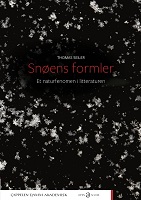Snøens formler
Et naturfenomen i litteraturen
| dc.contributor.author | Seiler, Thomas | |
| dc.date.accessioned | 2023-02-13T14:52:54Z | |
| dc.date.available | 2023-02-13T14:52:54Z | |
| dc.date.issued | 2023 | |
| dc.identifier | OCN: 1365607109 | |
| dc.identifier.uri | https://library.oapen.org/handle/20.500.12657/61240 | |
| dc.description.abstract | In her well-known song, ‘Når himmelen faller ned’ (‘When the Sky Falls Down’), the Norwegian musician Anne Grete Preus described snow as ‘celestial tipp-ex’ and a mighty ‘wonder’. But what exactly is it that snow corrects? And what gives snow its power? Snow’s Formulas: A Natural Phenomenon in Literature attempts to answer these and similar questions by discussing the motif of snow in the context of modernization processes marked by increasing instrumentalization and rationalization. Snow transforms landscapes and defies modernity’s innovations; it simultaneously obscures and accentuates, and also enchants. This process can be described in different ways: as the sublime’s breakthrough in a philosophical, aesthetic sense, or, in a poetological sense, as non-mimetic writing. This strategy plays out in language, and the objective of this study has been to investigate snow’s rhetoricity and how literary depictions of snow can be in response to the challenges of modernity. The book includes readings of texts by H.C. Andersen, Olaf Bull, Hans Børli, Paul Celan, Alexander Kielland, Jonas Lie, Tor Ulven and Tarjei Vesaas, among others. The relationship between snow and modernity is illustrated from a dual perspective. Emphasis is placed on the individual’s position and self-perception within the process of modernization, as well as on the aesthetical problems that arise when writing about snow. Snow makes a white surface; it ‘overwrites’ the ground and encourages a non-mimetic poetry. Snow can be said to be an engine of modern aesthetics that does not take language’s referential aspect for granted. | en_US |
| dc.language | Norwegian | en_US |
| dc.subject.classification | thema EDItEUR::D Biography, Literature and Literary studies::D Biography, Literature and Literary studies::DS Literature: history and criticism | en_US |
| dc.subject.classification | thema EDItEUR::D Biography, Literature and Literary studies::DS Literature: history and criticism::DSA Literary theory | en_US |
| dc.subject.classification | thema EDItEUR::Q Philosophy and Religion::QD Philosophy::QDH Philosophical traditions and schools of thought::QDHR Western philosophy from c 1800::QDHR5 Phenomenology and Existentialism | en_US |
| dc.subject.classification | thema EDItEUR::W Lifestyle, Hobbies and Leisure::WN Nature and the natural world: general interest::WNW The Earth: natural history: general interest::WNWM Weather and climate: general interest | en_US |
| dc.subject.other | snow theme, poetological writing, modernity, literature, phenomenology, memorialization, snømotiver, poetologisk diktning, modernitet, litteratur, fenomenologi | en_US |
| dc.title | Snøens formler | en_US |
| dc.title.alternative | Et naturfenomen i litteraturen | en_US |
| dc.type | book | |
| oapen.abstract.otherlanguage | I sin kjente låt Når himmelen faller ned betegner Anne Grete Preus snø som «himmelsk korrekturlakk» og et mektig «under». Men hva er det egentlig som snø må korrigere, og i hva består dens makt? Snøens formler: Et naturfenomen i litteraturen søker svar på slike spørsmål idet snømotivet diskuteres på bakgrunn av moderniseringsprosessen, kjennetegnet ved økende instrumentalisering og rasjonalisering. Snø forandrer landskapet og sier modernitetens nyttetenkning imot; den tildekker og aksentuerer samtidig og fortryller. Denne prosessen kan beskrives på forskjellige måter: som det sublimes gjennombrudd i filosofisk-estetisk henseende, eller, i poetologisk henseende, som en form for avrealisering. Denne strategien utspiller seg i språk, og formålet med denne studien er å granske snøens retorisitet og hvordan den litterære fremstillingen av snø svarer på modernitetens utfordringer. Boken inneholder lesninger av blant annet H.C. Andersen, Olaf Bull, Hans Børli, Paul Celan, Alexander Kielland, Jonas Lie, Tor Ulven og Tarjei Vesaas. Forholdet mellom snø og modernitet belyses fra et dobbeltperspektiv. Søkelyset rettes på individets stilling og selvforståelse i moderniseringsprosessen, men også på estetiske spørsmål som reiser seg når det diktes om snø. Snøen lager en hvit flate, den «overskriver» jorden og spiller på denne måten en amimetisk poetikk i hendene. Snø kan sies å være en pådriver av en moderne estetisk posisjon som ikke tar språkets referensielle side for gitt. | en_US |
| oapen.identifier.doi | 10.23865/noasp.178 | en_US |
| oapen.relation.isPublishedBy | bf7b42a4-6892-42e3-aaf8-8f32c8470a8b | en_US |
| oapen.relation.isFundedBy | f7b396fc-8081-43e7-b5ac-05c891debd1e | en_US |
| oapen.relation.isbn | 9788202791155 | en_US |
| oapen.relation.isbn | 9788202792213 | en_US |
| oapen.relation.isbn | 9788202792220 | en_US |
| oapen.relation.isbn | 9788202792237 | en_US |
| oapen.pages | 322 | en_US |
| oapen.place.publication | Oslo | en_US |

